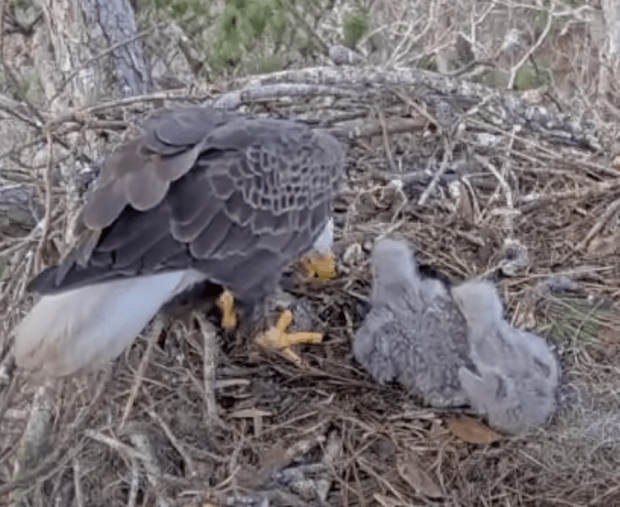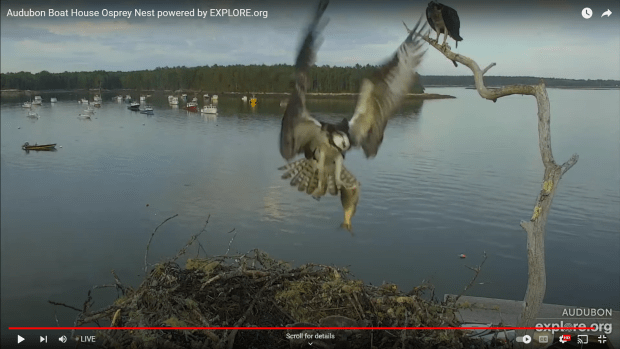12 January 2022
Good Morning Everyone,
I hope that the week has been good to you. I think of everyone in the paths of the storms that I am reading about and I hope that all of you are safe.
I am repeating the story of Jackie laying her first egg. 3884 people were watching the nest at the time. It went up to over 4000. Incredible. Jackie and Shadow are much loved. It just made me giddy and all of us wish this couple the very best of luck this year. Let us hope for good weather, no predators and nothing untoward.
From the Bookshelf:
I continue to sing the praises of Slow Birding. It is my pick of all the books I have read so far as being one of the most informative and easy to understand. If you like picture books, it is not for you!!!!! Last night I tackled the chapter on American Coots. They visit us and last summer I had the privilege of seeing several at the ponds around our city on a daily basis. I want to share with you what I learned – it is fascinating.
Coots are not ducks. They are rails but they spend their time in the water – like a duck. Their bodies are a deep espresso brown black, the head a darker shade than the body. Their bill is white with a shield that ranges in colour from a deep red-brown to brick red. You can see this below. They have red eyes. Stunning. Their secondary feathers have a white trim and there is a tiny white line going down the middle of the tail to its tip. Their feet have toes and those toes have evolved over time to have phalanges that help them to swim.

“American Coot (Fulica americana)” by Jacob McGinnis is licensed under CC BY-NC 2.0.
In the image below notice the red on the head of the chick.

“Mud Hen or American Coot (Fulica americana) feeding her baby” by Peggy2012CREATIVELENZ is licensed under CC BY 2.0.
Some interesting facts about Coot behaviour:
- Baby Coots have red heads. When predators are about they will stick their heads deep into leaves or into the nest so the predator cannot see them. As they age they can dive and camouflage their head by being under water. There is, on average, a five day spread between the first hatch and the last.
- Adult Coots can tell the parasitic eggs (eggs laid by another Coot in their nest) from their own eggs due to patterns on the shell.
- Adult Coot parents divide up the brood – older chicks with fading red heads and younger ones with red feathers. Chicks who kept their red feathers were the favourites of the adults to be fed. Unlike ducklings who can forage themselves, baby Coots are fed by the parents.
Making News:
Did you know that the Kakapo Recovery group check out the Rimu fruit, essential for Kakapo survival, to determine when breeding will begin? I didn’t.

More raptors are arriving in wildlife rehabilitation centres now that they are having to scavenge for food. Often this means that they are eating the innards left from hunters in the fields and woods – those are loaded with lead and it sends them right into care if they don’t die first. Sadly, this Golden Eagle got help but it was too late. This is entirely preventable. Write your representatives and urge them to ban all levels of lead in fishing and hunting equipment! Now. Thank you.



I would give just about anything to see a pile of ducks quacking away in my local park’s pond. They will return in the late spring. For now I have to rely on stories of others. I hate no idea, however, that Wigeons whistled, did you?
Nest News:
How many of you worried and fretted that Connie had not fed the little eaglet? I sure did! Connie has now fed the eaglet – about 24.5 hours after it hatched! Yippeee. Oh, I bet that first bite of fish tasted good! Little one holding its head up nicely. There is no sign that the second egg is pipping but it could be. Perhaps the egg that hatched was actually the second one laid. We wait. The raptors will teach us patience whether we like it or not!

Connie fed the little one again at 13:39 and at 14:20. I am making an assumption that the feedings will be nearly hourly from this point onwards for a few days during daylight hours. Clive has brought in Mullet and Trout. Good job, Dad.


Thursday>. No obvious pip in the second egg at Captiva.

Oh, that little one at the KNF E1 nest of Anna and Louis is just a cute little butterball. Will that second egg hatch? I cannot see a pip there either. Oh, those little wings. Adorable. Just adorable. No signs of a pip in the other egg.

I do not see a pip on the second egg at KNF-E1 Thursday morning either but it could be there.

One big difference that you might notice is that Andria feeds her eaglets more often than Anna. That is a really good thing for those two eaglets especially the second hatch as it remains much smaller than the first. Both are being civilised and both are well fed and cared for – no worries here.





Jack and Diane were bringing in bark to the nest in St Petersburg Florida. I am sure hoping that they leave it as a liner to cover up that hole. Last year their eggs rolled in there and with the help of Crows, the couple had no osplets. The year prior they fledged three. Diane’s leg appears to be improving daily.





Both PePe and Muhlady have brought in fish to the nest. These eaglets, Pearl and Tico, are so lucky. What a great source for fish their nest has.


Pearl is really getting her juvenile feathers.

Just look at this beautiful eaglet.

Gabby and V3 were both at the nest this morning. V3’s talons have really taken a beating but they appear healing or healed. Then off to secure the territory while Gabby stays home! What a guy.

Gabby lets out a big cry at 09:46.

Both V3 and Gabby are at the nest tonight on their respective perches watching for intruders and probably hoping to get some rest.

We have all noticed the large number of intruders at Gabby’s nest – and, of course, no Samson is what started all of this. The Centre for Conservation Biology has noticed that Bald Eagles spend more time guarding than they did 20 years ago due to the growing number of eagles in the area. Here is an article that arrived in my inbox today. It really sheds some light on what could be happening in The Hamlet.
They continue to work on the nest at Big Bear. With body temperatures of 105 degrees, Jackie and Shadow can melt the snow on the nest very quickly. Keep an eye out for any fluff being brought to the nest bowl. That will signal egg laying.




Well, goodness. I said watch for the eagles to bring in soft nesting material and look what happened late Wednesday afternoon!

That nest bole has been occupied for longer than an hour. I am not ready for this! But it just might be that Jackie is!!!!!!!!!!! She certainly wouldn’t listen to me.

Oh, tears. Jackie just laid her first egg. Beautiful. Between 1557 and 1600. Jackie made it look easy.



There is a fully history of the Big Bear nest under the streaming cam. It is very possible that Jackie is the 2012 hatch of Ricky and Lucy. In 2019, Shadow arrives at the nest and refuses to leave. Eventually, Jackie’s mate Mr BB leaves the area. Jackie and Shadow fledged Cookie and samba in 2019. Tragedy strikes for the pair in 2020 and 2021. Last year Jackie laid eggs on 22 January and 25th. One of those hatched. It was Spirit who stole our hearts and who fledged on 31 May.
Jackie was still keeping that precious egg safe at 1800.

E21 and 22 are really enjoying the fish that was brought in on Wednesday. they are cuties. Both M15 and Harriet fed the little ones fish and both were nicely behaved. Yes.



Indigo loves bringing beetles into the scrape that he has caught. Today there were four that Elain caught in her video! Indigo is so proud of his catch.

Ron and Rose are still working on the nest in Miami-Dade. Today, Ron brought Rose a fish in the nest. How sweet.


I am waiting for the pip watch at Berry College for Pa Berry and Missey. Last year they raised a strong eaglet B15 that stayed in the area and entertained people well into the fall with his flying skills. They are not on YouTube. You must Google Berry College Eagle Cam.

The eagles are working on the nest at Duke Farms.

And the new couple at the Captiva Osprey nest, MO and FO, are working on eating a catfish (or is it a shark?) and mating at the same time. Good luck with that.

Thank you so very much for being with us today. Please take care. See you soon.
Thank you to the following for their posts, videos, tweets, and streaming cams that make up my blog: Openverse, Kakapo Recover, Terry Carman and Bald Eagles Live Nest Cams and News, The Guardian, Window to Wildlife, NF-E1 and E3, Achieva Credit Union, Superbeaks, NEFL-AEF, Centre for Conservation Biology, FOBBV, SWFL Bald Eagles and D Pritchett, Charles Sturt University Falcon Cam and Cilla Kinross, Elain and Charles Sturt Falcon Cam, WRDC, Berry College Bald Eagles, and Duke Farms Bald Eagles.








































